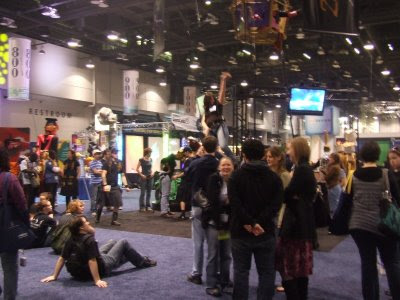
Today's excitement on the floor was Foy, ZFX, and Hall Associates flying people. The above picture is the ZFX rig.
Besides spending a few remaining minutes on the show floor, I saw two sessions today. The first was "Technical Design / Direction - In a Disney Theme Park". Chuck Davis gave an interesting view into the scale and process that goes into creating a major park element. I think what was interesting to me was the degree that they come up with an idea, but they have to internally sell the idea to get funding. Since these projects are worth millions, they spend hundreds of thousands of dollars proving the ideas and methods as they proceed. While we certainly don't produce on the scope of Disney, we also often don't invest in enough time planning and determining if something will work before we are well into the process and committed. I think sometimes we would be well served to remember that spending some preliminary funding to investigate a technique before commitment allows for a smoother process, and money saved in the long run.
Next I went to "Draw Me a Picture: Collaborative Problem Solving through Digital Storyboarding". It was chaired by Robert W. Johnson, and the presenters included Gregory K. Bell, and Greg Stump. The session was an interesting view on how technology is improving and growing as a communication tool. Some of the packages that we receive are fully storyboarded, and 3-D rendered, and I suspect that much of that is to sell the product, not really for building, but it helps on the build side as well. In 3D Studio Max they showed off the section tool to get 2-D sections from a complex 3-d shape. That is a handy feature, but not enough for me to buy the program. They also talked about modeling a complex 3-D shape (a bust for Mozart) and then doing a section about every 1/2, which was then used to machine the shape. After that they did fine tooling, and made a mold from the piece to make multiples. As great as cnc machining is, I take from this, that it still isn't to the place where it is easier to simply machine something than it is to make a mold and cast duplicated. (Which for complex 3-D items is true where I work as well). The other design they talked about was a structure used for Jesus Christ Superstar where the cross was on a cantilevered beam, and after being crucified, the cross slid back, leaving Jesus hanging against a black background. The set was cool, and the 3-D software helped them animate the sequence to make sure that everyone knew what they were looking for and to help start the technical discussions. The middle part of the session was about how they accomplished the effect. The last part largely revolved around SketchUp. having heard and seen alot of the program, I fully agree to its usefulness. The presenter showed using it to define the structure, and building off of drawings created by SketchUp. This is certainly intriguing, and though he said the tolerances were much more precise than what we need in theatre, I still am suspect. For instance I know some people who routinely use it for preliminary design development, but when it comes time to build, the tolerances are usually +/- inches - far too big to use for build.
The last session of the conference for me was "Tricks of the Stage - Stage Magic". It was nice to see so many prop related sessions this year, and I enjoyed this one as well. John M. Lavarnway chaired the session and went through, with input from his other panelists, how to put together the effect. He stressed defining the effect, research, covering liability concerns, reliability concerns, and how to work with the Actors with the trick. They then showed a variety of effects such as using solenoids for Blithe Spirit, the throwing knife trick, and turning wine into water.
By the time that session let out the expo had been closed for about 45 minutes or so, and the strike was quickly proceeding.



No comments:
Post a Comment